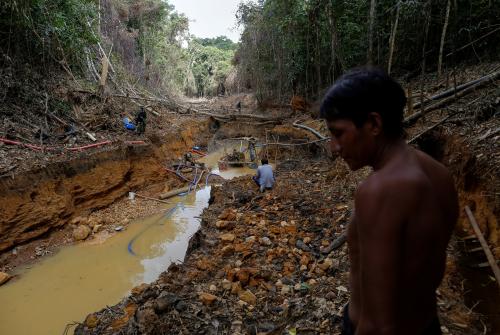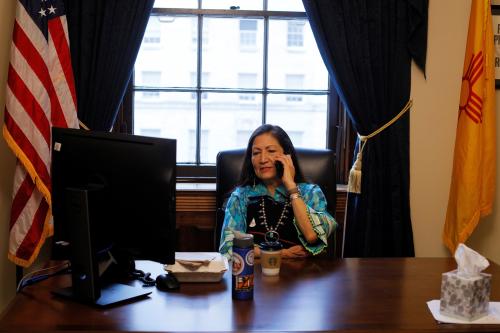American Indian land rights are our country’s oldest policy arena and one that has remained potent since Christopher Columbus landed in the Americas 527 years ago this week. Historically, American Indian tribes have been relegated to the bottom rung of power between governments, corporations, and tribes. However, in recent years, issues of tribal sovereignty have come to the fore of public discussion. Recent policy proposals by members of the Democratic Party are pushing contemporary discourse about indigenous land rights into uncharted terrain. Some politicians are calling for free, prior, informed consent (FPIC) of American Indian tribes over decisions that affect their people and land. Though FPIC is far from becoming law, its entrance into the American policy discussion marks an increasing mainstreaming of policy issues related to our country’s indigenous peoples.
FPIC processes governing resource extraction on indigenous lands constitute a more rigorous standard than that of consultation. Under the standard of consultation, the federal government is legally required to consult tribes and ensure “regular and timely input by tribal officials” on matters that affect them; yet, it does not necessitate their agreement for extraction to take place. FPIC, on the other hand, as Tara Ward notes—and per its name—“is the right of indigenous peoples to make free and informed choices about the development of their lands and resources.” Crucially, in contrast to consultation, FPIC requires tribal consent before extraction is undertaken.
While FPIC is gradually emerging as a best practice for indigenous land rights around the globe, it has never been applied in the United States. However, recent proposals in the United States by Rep. Alexandria Ocasio-Cortez (D-N.Y.) and Sen. Ed Markey (D-Mass.) in their Green New Deal outline and by presidential candidates Elizabeth Warren and Julián Castro in their proposed American Indian policies embrace this policy. Ocasio-Cortez’s and Markey’s proposal, a nonbinding resolution whose sweeping provisions are intended to combat the climate crisis and advocate for environmental justice, calls for the “free, prior, and informed consent of indigenous people for all decisions that affect indigenous people and their traditional territories.”
Warren’s proposed policy similarly notes that “respect for tribal sovereignty means that no project, development or federal decision that will have a significant impact on a tribal community, their lands, resources, members or religious practices, should proceed without the free, prior and informed consent of the Tribal Nation concerned.” Castro’s proposal more modestly calls for requiring FPIC from indigenous communities only for “major” infrastructure projects, rather than all initiatives, and only on federal lands, instead of all lands that impact the tribes.
Should even one be approved, these FPIC policy proposals would place the United States at the cutting edge of indigenous rights law. While the right of indigenous peoples to be consulted has become accepted as customary international law (meaning that it is legally binding on all states, not merely those that have ratified a particular treaty), the full right to FPIC has not been accepted as such, and the United States has hitherto shied away from leading the field.
The International Labour Organization’s Convention Concerning Indigenous and Tribal Peoples in Independent Countries of 1989 (ILO 169) is the only international indigenous rights treaty that is legally binding on those countries that ratify it. ILO 169 falls short of calling for the FPIC of indigenous peoples for resource extraction projects on or near their land, calling only for governments to
“establish or maintain procedures through which they shall consult these [indigenous] peoples, with a view to ascertaining whether and to what degree their interests would be prejudiced, before undertaking or permitting any programmes for the exploration or exploitation of such resources pertaining to their lands. The peoples concerned shall wherever possible participate in the benefits of such activities, and shall receive fair compensation for any damages which they may sustain as a result of such activities.”
Only 23 countries have ratified ILO 169. The United States is not among them.
The other major indigenous rights agreement is the 2007 United Nations Declaration on the Rights of Indigenous Peoples (UNDRIP)—a General Assembly resolution that is not legally binding under international law. UNDRIP outlines a framework for consultation and redress mechanisms for resource extraction and other violations of rights, but also does not contain a true FPIC provision for resource extraction. While UNDRIP declares that
“States shall consult and cooperate in good faith with the indigenous peoples concerned through their own representative institutions in order to obtain their free and informed consent prior to the approval of any project affecting their lands or territories and other resources, particularly in connection with the development, utilization or exploitation of mineral, water or other resources,”
this has widely been interpreted as requiring not consent but consultation with the goal of obtaining consent.
The United States was one of four countries to vote against the adoption of UNDRIP, arguing that the resolution’s language surrounding indigenous peoples’ “right to self-determination” could infringe upon the sovereignty of the United States by constituting an indigenous right to statehood. In 2010, however, Barack Obama announced that the United States would be lending its support to UNDRIP, thereby reversing the government’s position. While some hailed the announcement as a step forward for American Indian rights, the Obama administration’s subsequent interpretation of each of the resolution’s FPIC provisions as calling for “a process of meaningful consultation with tribal leaders, but not necessarily the agreement of those leaders, before the actions addressed in those consultations are taken,” proved another obstacle in the path of a true consent provision. The Obama administration further made no effort to enshrine UNDRIP’s precepts into domestic law.
This conflict between indigenous activists, governments, and companies over land rights burst into the national discussion in early 2016 with the Standing Rock Sioux’s protest of the Dakota Access Pipeline (DAPL) in North Dakota. The oil pipeline—whose route went upstream of the reservation, touching on tribal sacred sites and burial places and risking their water supply—had been fast-tracked through the permitting process. Though the pipeline’s parent company, Energy Transfer Partners, was legally obliged to consult the Standing Rock Sioux and other tribes before finalizing the pipeline route, the Standing Rock Sioux refused to participate in the consultation on the grounds that the discussion was both too hasty and too narrowly defined. Pipeline construction went ahead without their input.
The tribe immediately filed an injunction and set up a protest camp; soon, the protest was joined by members of hundreds of American Indian tribes, as well as professional activists. Gaining national attention under the hashtag #NoDAPL, the protesters—who numbered 15,000 at the height of the protest—pushed issues of sovereignty, land rights, water rights, and cultural heritage into the national discussion as never before in recent years. The Obama administration eventually halted construction of the pipeline. However, in February 2017, the decision was reversed by the Trump administration, which argued that the investments in American energy infrastructure that the pipeline represented “serve the national interest.” Construction resumed, and in June 2017, oil began flowing through the pipeline.
While the #NoDAPL movement did not succeed in its ultimate goal of halting construction of the pipeline, it did widely publicize the issue of American Indian land rights. Indeed, the Green New Deal and presidential candidate policy proposals both reflect an increased awareness of American Indian sovereignty. Warren’s proposal, for example, explicitly ties FPIC to the DAPL protests and Keystone XL (another controversial pipeline), noting that FPIC “interests were not respected in the case of President Trump’s permitting decisions for Keystone XL and Dakota Access.” Coupled with a greater understanding among policymakers of the importance of FPIC rights, American Indian activism points to a future that does a better job respecting indigenous land rights than centuries previous. The introduction of FPIC into the policy discussion is, perhaps, a sign of a new trend toward increasing American Indian rights.
Anna Green performed fact-checking for this post.







Commentary
On Indigenous Peoples Day, new ideas for American Indian land rights
October 14, 2019